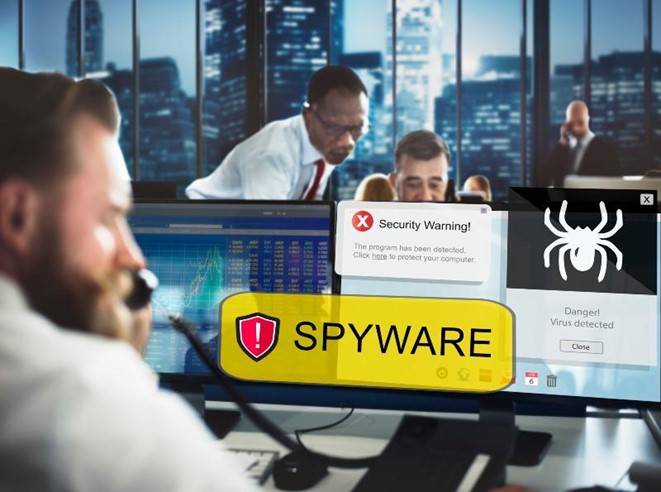Our devices have become gatekeepers of personal and professional information. However, they have also become targets for cybercriminals. One of the most common, though not always visible, risks is spyware.
But what is spyware, how does it affect your digital assets, and, most importantly, how can you protect yourself? This article explains it all.
What is spyware?
Spyware is malicious software designed to infiltrate devices and collect information without your consent.
This software works in the background, spying on your device’s activity, such as the websites you visit, the passwords you enter, or even your private conversations. Sometimes, it can even take partial control of your computer or mobile to perform malicious activities.
Spyware compromises your privacy and digital assets, such as bank details, access credentials to sensitive services, or critical corporate information.

Most prominent types of spyware
Now that you know what spyware is, you should know that not all of them work the same way. Here are some of the most common types of spyware:
- Keyloggers. These programs record every keystroke you make on your device. They are used to capture passwords, usernames, and other sensitive data.
- Adware. While their primary intent is to display unwanted ads, some adware also collects browsing data to personalize those ads and sell your information to third parties.
- Remote Access Trojans (RATs). They allow attackers to control your device remotely. They can activate your camera, access your files, or even install other malware without you noticing.
- Mobile spyware. These programs are specifically designed to collect data from mobile phones. From text messages and GPS locations to contact lists or call recordings, this spyware can turn your phone into a spying tool.
Spyware: Famous Examples
Some spyware cases have achieved worldwide notoriety due to their massive impact:
- Pegasus. An extremely sophisticated spyware used to spy on journalists, activists, and politicians. This program infected mobile devices without the need for user interaction.
- CoolWebSearch. This spyware modifies the web browser to redirect to malicious pages and collect information from users.
- FinFisher. Used by governments and criminals alike, this spyware is designed to monitor devices in advanced ways.
These examples remind us that spyware is not a minor problem or limited to famous people. We can all be at risk at some point.
How do you remove spyware?
If you suspect that your device is compromised, here are the basic steps to detect and remove spyware:
- Identify signs of infection
- Your device is slower than usual.
- Unexpected pop-up ads appear.
- Changes to your browser, such as a new homepage.
- Unusually high battery or data consumption.
- Use anti-malware tools. Install reputable programs like Malwarebytes or Norton to scan your device and remove any detected spyware.
- Update your operating system and apps. Cybercriminals often exploit vulnerabilities in outdated software. Always keep your programs up to date.
- Reset your device to its factory settings. If the infection persists, this can be an extreme but effective solution. Make sure to back up your important data before proceeding.
- Consult a professional. If you’re unsure how to proceed, contact a cybersecurity expert who can help you clean and protect your device.

How to protect yourself from future spyware attacks
You already know the primary keys to knowing what spyware is and should understand that prevention is the best defense against this attack. Here are some key practices:
- Only download apps from trusted sources. Avoid installing programs from unknown or dubious websites.
- Be wary of suspicious emails. Don’t click on links or download files from senders you don’t recognize.
- Use up-to-date security software. Install and keep a good antivirus and antimalware program active.
- Set up strong passwords. Use unique combinations of letters, numbers, and special characters, and avoid using the same password for different accounts.
- Turn on two-factor authentication (2FA). This adds an extra layer of security, making it difficult to gain unauthorized access even if someone gets your password.
Your Cyber Surveillance Ally: Protect What You Value Most
In today’s landscape, protecting your digital assets is not an option but a necessity. At Enthec, we offer cyber surveillance solutions to protect your information from threats like spyware.
If you’re looking to identify breaches and spot issues that have overcome guardrails, we’re here to help.
Spyware is a real threat that affects both individuals and businesses. By knowing what it is, how it works, and how to prevent it, you can take a firm step towards protecting your digital assets. Remember: in cybersecurity, staying one step ahead of attackers is crucial.
Would you like to know more? Enthec is here to help.


